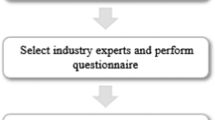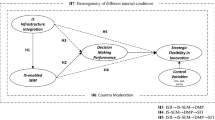Abstract
Throughout the world, hospitals are under increasing pressure to become more efficient. Efficiency analysis tools can play a role in giving policymakers insight into which units are less efficient and why. Many researchers have studied efficiencies of hospitals using data envelopment analysis (DEA) as an efficiency analysis tool. However, in the existing literature on DEA-based performance evaluation, a standard assumption of the constant returns to scale (CRS) or the variable returns to scale (VRS) DEA models is that decision-making units (DMUs) use a similar mix of inputs to produce a similar set of outputs. In fact, hospitals with different primary goals supply different services and provide different outputs. That is, hospitals are nonhomogeneous and the standard assumption of the DEA model is not applicable to the performance evaluation of nonhomogeneous hospitals. This paper considers the nonhomogeneity among hospitals in the performance evaluation and takes hospitals in Hong Kong as a case study. An extension of Cook et al. (2013) [1] based on the VRS assumption is developed to evaluated nonhomogeneous hospitals’ efficiencies since inputs of hospitals vary greatly. Following the philosophy of Cook et al. (2013) [1], hospitals are divided into homogeneous groups and the product process of each hospital is divided into subunits. The performance of hospitals is measured on the basis of subunits. The proposed approach can be applied to measure the performance of other nonhomogeneous entities that exhibit variable return to scale.




Similar content being viewed by others
References
Cook WD, Harrison J, Imanirad R, Rouse P, Zhu J (2013) Data envelopment analysis with nonhomogeneous DMUs. Oper Res 61(3):666–676
Hollingsworth B, Dawson PJ, Maniadakis N (1999) Efficiency measurement of health care: a review of non-parametric methods and applications. Health Care Manag Scie 2(3):161–172. https://doi.org/10.1023/A:1019087828488
Cooper WW, Seiford LM, Zhu J (2011) Data envelopment analysis: history, models, and interpretations. Springer US, New York
Emrouznejad A (2014) Advances in data envelopment analysis. Ann Oper Res 214(1):1–4. https://doi.org/10.1007/s10479-014-1535-4
Sherman HD (1984) Hospital efficiency measurement and evaluation: empirical test of a new technique. Medical Care 22(10):922–938. https://doi.org/10.1097/00005650-198410000-00005
Ozcan YA (1995) Efficiency of hospital service production in local markets: the balance sheet of US medical armament. Socio Econ Plan Sci 29(2):139–150. https://doi.org/10.1016/0038-0121(95)00006-8
Biørn E, Hagen TP, Iversen T, Magnussen J (2003) The effect of activity-based financing on hospital efficiency: a panel data analysis of DEA efficiency scores 1992–2000. Health Care Manag Scie 6(4):271–283. https://doi.org/10.1023/A:1026212820367
Ozcan YA, Lins ME, Lobo MSC, Da Silva ACM, Fiszman R, Pereira BB (2010) Evaluating the performance of Brazilian university hospitals. Ann Oper Res 178(1):247–261. https://doi.org/10.1007/s10479-009-0528-1
Narcı HÖ, Ozcan YA, Şahin İ, Tarcan M, Narcı M (2015) An examination of competition and efficiency for hospital industry in Turkey. Health Care Manag Scie 18(4):407–418. https://doi.org/10.1007/s10729-014-9315-x
O’Neill L, Rauner M, Heidenberger K, Kraus M (2008) A cross-national comparison and taxonomy of DEA-based hospital efficiency studies. Socio Econ Plan Sci 42(3):158–189. https://doi.org/10.1016/j.seps.2007.03.001
Grosskopf S, Valdmanis V (1987) Measuring hospital performance. A non-parametric approach. J Health Econ 6(2):89–107
Ozcan YA, McCue MJ, Okasha AA (1996) Measuring the technical efficiency of psychiatric hospitals. J Med Syst 20(3):141–150. https://doi.org/10.1007/BF02281992
Sahin I, Ozcan YA (2000) Public sector hospital efficiency for provincial markets in Turkey. J Med Syst 24(6):307–320. https://doi.org/10.1023/A:1005576009257
Grosskopf S, Margaritis D, Valdmanis V (2001) Comparing teaching and non-teaching hospitals: a frontier approach (teaching vs. non-teaching hospitals). Health Care Manag Sci 4(2):83–90
Gruca TS, Nath D (2001) The technical efficiency of hospitals under a single payer system: the case of Ontario community hospitals. Health Care Manag Scie 4(2):91–101. https://doi.org/10.1023/A:1011401510010
Kirigia JM, Emrouznejad A, Sambo LG (2002) Measurement of technical efficiency of public hospitals in Kenya: using data envelopment analysis. J Med Syst 26(1):39–45
Grosskopf S, Margaritis D, Valdmanis V (2004) Competitive effects on teaching hospitals. Eur J Oper Res 154(2):515–525
Simões P, Marques RC (2011) Performance and congestion analysis of the Portuguese hospital services. Cent Eur J Oper Res 19(1):39–63. https://doi.org/10.1007/s10100-009-0122-2
Grosskopf S, Margaritis D, Valdmanis V (2001) The effects of teaching on hospital productivity. Socio Econ Plan Sci 35(3):189–204
O’Neill L (1998) Multifactor efficiency in data envelopment analysis with an application to urban hospitals. Health Care Manag Scie 1(1):19–27. https://doi.org/10.1023/A:1019030215768
Banker RD, Conrad RF, Strauss RP (1986) A comparative application of data envelopment analysis and translog methods: an illustrative study of hospital production. Manag Sci 32(1):30–44. https://doi.org/10.1287/mnsc.32.1.30
Harris J, Ozgen H, Ozcan Y (2000) Do mergers enhance the performance of hospital efficiency? J Oper Res Soc 51(7):801–811
Khushalani J, Ozcan YA (2017) Are hospitals producing quality care efficiently? An analysis using dynamic network data envelopment analysis (DEA). Socio Econ Plan Sci 60:15–23. https://doi.org/10.1016/j.seps.2017.01.009
Du J, Wang J, Chen Y, Chou SY, Zhu J (2014) Incorporating health outcomes in Pennsylvania hospital efficiency: an additive super-efficiency DEA approach. Ann Oper Res 221(1):161–172. https://doi.org/10.1007/s10479-011-0838-y
Ferrier GD, Trivitt JS (2013) Incorporating quality into the measurement of hospital efficiency: a double DEA approach. J Prod Anal 40(3):337–355. https://doi.org/10.1007/s11123-012-0305-z
Kacak H, Ozcan YA, Kavuncubasi S (2014) A new examination of hospital performance after healthcare reform in Turkey: sensitivity and quality comparisons. Int J Publ Policy 10(4–5):178–194. https://doi.org/10.1504/IJPP.2014.063073
Jacobs R (2001) Alternative methods to examine hospital efficiency: data envelopment analysis and stochastic frontier analysis. Health Care Manag Scie 4(2):103–115. https://doi.org/10.1023/A:1011453526849
Sahin I, Ozcan YA, Ozgen H (2011) Assessment of hospital efficiency under health transformation program in Turkey. Cent Eur J Oper Res 19(1):19–37. https://doi.org/10.1007/s10100-009-0121-3
De Castro Lobo MS, Ozcan YA, Da Silva AC, Lins MPE, Fiszman R (2010) Financing reform and productivity change in Brazilian teaching hospitals: Malmquist approach. Cent Eur J Oper Res 18(2):141–152. https://doi.org/10.1007/s10100-009-0097-z
Langabeer JR, Ozcan YA (2009) The economics of cancer care: longitudinal changes in provider efficiency. Health Care Manag Scie 12(2):192–200. https://doi.org/10.1007/s10729-008-9079-2
Al-Refaie A, Fouad RH, Li MH, Shurrab M (2014) Applying simulation and DEA to improve performance of emergency Department in a Jordanian hospital. Simul Model Pract Th 41:59–72. https://doi.org/10.1016/j.simpat.2013.11.010
Kounetas K, Papathanassopoulos F (2013) How efficient are Greek hospitals? A case study using a double bootstrap DEA approach. Eur J Health Econ 14(6):979–994. https://doi.org/10.1007/s10198-012-0446-z
DePuccio MJ, Ozcan YA (2017) Exploring efficiency differences between medical home and non-medical home hospitals. Int J Healthcare Manag 10(3):147–153. https://doi.org/10.1080/20479700.2015.1101913
Mitropoulos P, Talias ΜA, Mitropoulos I (2015) Combining stochastic DEA with Bayesian analysis to obtain statistical properties of the efficiency scores: an application to Greek public hospitals. Eur J Health Econ 243(1):302–311. https://doi.org/10.1016/j.ejor.2014.11.012
Walheer B (2018) Disaggregation of the cost Malmquist productivity index with joint and output-specific inputs. Omega 75:1–12. https://doi.org/10.1016/j.omega.2017.01.012
Cook WD, Zhu J (2011) Multiple variable proportionality in data envelopment analysis. Oper Res 59(4):1024–1032. https://doi.org/10.1287/opre.1110.0937
Chen Y, Ali AI (2002) Output–input ratio analysis and DEA frontier. Eur J Health Econ 142(3):476–479. https://doi.org/10.1016/S0377-2217(01)00318-6
Wang K, Xian YJ, Lee CY, Wei YM, Huang ZM (2017) On selecting directions for directional distance functions in a non-parametric framework: a review. Ann Oper Res:1–34
Acknowledgements
This paper was finished while Xiyang Lei was visiting the University of Strathclyde with financial support from the China Scholarship Council. Alec Morton would like to thank the University of Science and Technology of China for their hospitality while working on this paper, as well as the government of Anhui province for their support under the 100 Talents scheme. This research was supported by National Natural Science Foundation of China (Grant No.s 71271196 and 71701060), the Youth Innovation promotion Association of Chinese Academy of Sciences, the Science Fund for Creative Research Groups of the National Natural Science Foundation of China (Grant No. 71121061), the Fund for International Cooperation and Exchange of the National Natural Science Foundation of China (Grant No. 71110107024), the National Science Foundation of China for Distinguished Youth Scholars (Grant No. 71225002), Anhui Social Sciences Foundation (Grant No. AHSKY2017D78), and the Fundamental Research Funds for the Central Universities (Grant Nos. JZ2016HGBZ0996 and JS2017HGXJ0028).
Author information
Authors and Affiliations
Corresponding author
Electronic supplementary material
ESM 1
(DOCX 30 kb)
Rights and permissions
About this article
Cite this article
Li, Y., Lei, X. & Morton, A. Performance evaluation of nonhomogeneous hospitals: the case of Hong Kong hospitals. Health Care Manag Sci 22, 215–228 (2019). https://doi.org/10.1007/s10729-018-9433-y
Received:
Accepted:
Published:
Issue Date:
DOI: https://doi.org/10.1007/s10729-018-9433-y




